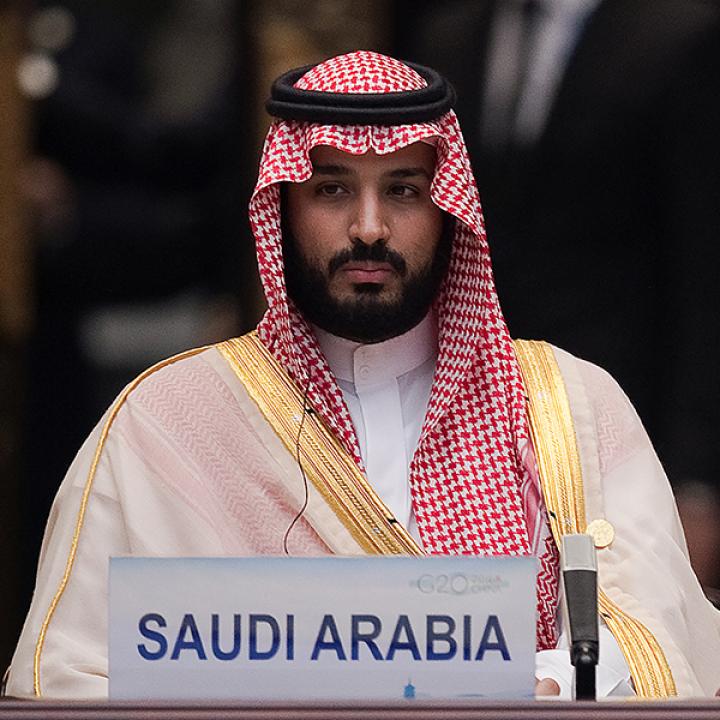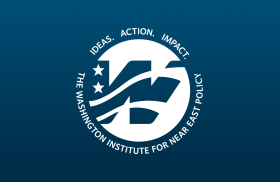
- Policy Analysis
- PolicyWatch 4137
Perspectives on Muhammad bin Salman’s Visit to Washington

Washington Institute experts discuss each government’s likely agenda for the landmark visit, from dealmaking in the energy and AI sectors to deepening the bilateral defense relationship and taking the difficult next steps in the fragile Gaza ceasefire plan.
Normalization Prospects and Gaza
By Dennis Ross
President Trump will host Saudi Crown Prince Muhammad bin Salman (MbS) again on November 18, but unlike their 2018 visit—when the prince spent three weeks traveling around the United States to explain the vast social and economic changes he was making in the kingdom—this trip will be limited to Washington. Designed to follow up on Trump’s May appearance in Riyadh, the prince’s trip is being billed as an “official working visit,” which quite effectively describes what their meetings will primarily be about: doing business. Many of the deals announced in May are now materializing, and their values are being increased.
In particular, both leaders are focused on the nexus of finance, artificial intelligence, and energy—the latter because of the huge amounts of electricity needed to power AI data centers. They seek to expand bilateral public and private partnerships in these areas; in fact, officials have apparently worked out some of the national security concerns about the transfer of technology, data, and chips in preparation for the visit.
Another central topic of discussion will be Israel—namely, the challenge of implementing the president’s Gaza peace plan and the related issue of normalizing relations between the two countries. Although the latter remains a priority, President Trump seems to understand that the Saudis will not move toward political normalization in the current environment. Before that can happen, they will need to see two things at minimum: the transformation of Gaza (meaning demilitarization, Israeli withdrawal, and reconstruction) and the emergence of a credible path toward a different future for the Palestinians. This does not rule out possible economic deals that include Israelis, but formal peace will have to wait—likely until after Israel’s next election in 2026.
As for President Trump’s twenty-point peace proposal, MbS will presumably reaffirm his public acceptance of the plan in principle. Yet practical Saudi engagement—including on easily supported items like reconstruction—will depend on Hamas being disarmed, and that process has not even begun.
Even if the Saudis do not intend to be part of the proposed International Stabilization Force (ISF) in Gaza, they can still play an important role in seeing some of the plan’s other twenty points implemented, these in particular:
- MbS should continue emphasizing that Gaza must be demilitarized before reconstruction can begin, and that Hamas cannot be permitted to play any role, directly or indirectly, in the territory’s governance. Saudi statements to this effect can help set the boundaries of what is considered acceptable.
- Point 19 of Trump’s plan—which holds that any steps toward Palestinian self-determination and statehood will depend on reforms being “faithfully carried out” within the Palestinian Authority—was inserted largely to meet Saudi domestic needs. Riyadh wanted a political horizon and got one. In fact, no American administration has ever publicly embraced self-determination for the Palestinian people, but President Trump has now done so. The “faithfully carried out” condition is crucial, however; without substantive reform, there will be no pathway, no political horizon, and no statehood. Hence, President Trump should make clear that the Saudis and their Arab allies must do their part to help deliver PA reform, even as Washington does its part with Israel.
No Treaty, but Defense Upgrades
By Elizabeth Dent
The U.S.-Saudi defense partnership is set to receive significant upgrades during the crown prince’s visit. First, building on longstanding U.S. security commitments to the kingdom, the two leaders are expected to announce an executive agreement that deepens the partnership. The Trump administration cannot deliver a Senate-ratified mutual defense treaty in the current political environment, but the Saudis will no doubt expect something stronger than the president’s recent executive order “assuring the security” of fellow Gulf state Qatar.
Second, the visit will advance the $142 billion arms package announced during President Trump’s May visit to Riyadh. If the final package includes F-35s, it will mark the first time those jets have been sold to an Arab military. Numerous questions surround such a sale, including how the administration would uphold the U.S. legal requirement to ensure Israel’s qualitative military edge in the Middle East while still meeting Saudi expectations. True, the F-35 platform would take years to deliver to the kingdom regardless of its specifications, so a sale would not affect regional security in the near term. Yet the mere act of approving the purchase would be an important step for the U.S. defense industry and could open doors for additional Arab partners to acquire similar configurations more easily.
To dispel potential accusations of deeper U.S. entanglements abroad, the Trump administration has framed the nascent executive agreement and expanded arms sales as a way of shifting more security responsibility to capable regional partners while preserving stability—and U.S. influence—in the Middle East. In exchange, Trump will likely seek more active Saudi involvement in advancing the Gaza ceasefire agreement, especially on “day after” planning related to funding reconstruction and ensuring Hamas has no role in governance.
Reaffirming Riyadh’s Regional Leadership
By April Longley Alley
The Saudi visit comes at a time when the kingdom is playing a more robust diplomatic leadership role in the Middle East and beyond. In the past several years, Riyadh has restored ties with Iran through a Chinese-backed agreement, rallied global support for a two-state solution to the Israeli-Palestinian conflict, led efforts to bolster Syria’s new government, backed diplomacy to end Yemen’s civil war, and sought to mediate the conflicts in Sudan and Ukraine. This stepped-up diplomacy is part of a trend among Gulf states, who have mostly eschewed the internal feuds and regional military interventions that characterized their policies during Trump’s first term in favor of de-escalation.
For MbS, diplomacy and regional stabilization help serve his core domestic agenda of ambitious economic diversification. He also seeks to build the kingdom’s credentials as a middle power with an independent foreign policy, balancing close alignment with the United States and ties with China and Russia amid increased global competition and uncertainty. His Washington visit is both an important affirmation of these credentials—particularly to local and regional audiences—and a continuation of his efforts to redefine and deepen the Saudi partnership with the United States on multiple fronts. Appearing at the White House is even more notable today given President Trump’s recent executive order promising to defend Qatar. Saudi Arabia views itself as a leader in the Gulf and Arab world and will no doubt seek to demonstrate that the scope of its relationship with Washington still exceeds that of other Gulf partners.
President Trump seemed to embrace Riyadh’s regional leadership role by making Saudi Arabia the inaugural international trip of his second term, and by quickly following the crown prince’s advice on embracing Syria’s new government. In principle, Trump and MbS are well-aligned in their preference for de-escalation and dealmaking over military confrontation. Yet Riyadh disagrees with another key U.S. ally—Israel—on how to address threats from Iran and resolve the Palestinian demand for statehood, creating a dilemma for Washington. For this visit, threading the needle between these two allies will mean that Trump’s push for Israeli-Saudi normalization is out of reach. Still, his administration will almost certainly seek Saudi help on a range of other regional issues, including Gaza.
Notably, any guarantees for Saudi Arabia’s defense may have profound implications for Yemen’s civil war and the Houthi threat to freedom of navigation and regional security. Although Yemen will not be a focus of next week’s discussions, more robust U.S. security guarantees would strengthen the kingdom’s hand with the Houthis, who have been threatening to resume cross-border attacks and fighting inside Yemen if Riyadh does not end the war on their terms. More specifically, the Saudis could use this leverage to deter new attacks and help forge a more balanced and durable agreement to end the conflict.
Continuing the Investment Momentum
By Simon Henderson
The crown prince’s visit comes just three weeks after the latest Future Investment Initiative conference in Saudi Arabia, known as “Davos in the Desert.” As usual, the event attracted top American business executives (e.g., the heads of J.P. Morgan, Goldman Sachs, and BlackRock) as well as political leaders like Chinese Vice President Han Zheng—a reminder that Beijing is a major U.S. competitor in the kingdom.
The conference was also another demonstration of Riyadh’s Vision 2030, a plan for implementing widespread social and economic change across the kingdom while raising the country’s global profile. Advancing the bilateral partnership with Washington and gaining access to American technology, innovation, and industry are critical for realizing those objectives.
On the margins of the prince’s working visit, officials will host another investment conference in Washington. This deliverable is important for both leaders as they attempt to show their publics that deeper economic ties benefit both countries and both economies. They also realize the need to deliver on the Saudi commitment from earlier this year to invest a trillion dollars in the American economy. Even if that target is not achieved over the remainder of Trump’s term, the intense focus on investment underscores a key theme of his administration: that economic security is part of national security.
The China Factor
By Henry Tugendhat
During previous U.S. administrations, the Saudis confidently raised the profile of their relations with China in part to spur Washington into engaging more deeply with them. And given the kingdom’s perception that U.S. policy can be unpredictable from administration to administration—and even within the same administration—it will assuredly continue taking the approach adopted by many of its Gulf neighbors, namely, balancing ties with the United States and China. To be sure, Riyadh is currently downplaying relations with Beijing amid the crown prince’s pending White House visit, yet the fact is they continue to grow.
In the spirit of aligning the kingdom more closely with the United States, the head of Saudi Arabia’s new artificial intelligence startup Humain recently vowed to stay away from chips made by the Chinese firm Huawei. He also cited the upcoming royal visit as an opportunity to secure more chip exports from leading American firms. But that does not mean the kingdom wishes to reduce its overall engagement with China. For one thing, dealing with Chinese firms has presented unique economic opportunities for a wealthy Middle Eastern country that seeks to diversify beyond oil exports. The Saudis have also been willing to work with Beijing for their own security interests, particularly in regard to their difficult relations with Iran.
For its part, China has often sought to present itself as an impartial partner to all countries in the region, even when its support for Iran or Syria’s former Assad regime rankled the Saudis and other Arab governments. That said, Beijing seems to recognize the kingdom as the most significant and influential Arab power and has invested more in that relationship accordingly. Yet Chinese foreign policy elites simultaneously argue that their country’s economic interests in the Middle East are often best served when other external powers (like the United States and Europe) bear the main burden of fostering regional stability. As such, although China may try to sell more weapons to Riyadh and hold occasional joint training exercises with the kingdom, it is unlikely to pursue a much greater role in the Saudi security architecture anytime soon.
Energy Diversification and AI
By Noam Raydan
Maintaining American AI dominance is a top priority for the Trump administration, and this race requires not only a resilient mix of energy sources and secure supply chains, but also global partnerships. Saudi Arabia has a similar ambition of becoming a global hub for AI innovation. To that end, it is betting that its plentiful, low-cost energy will be seen as a key resource for powering data centers and attracting investments. During President Trump’s May visit to the kingdom, officials struck AI-related deals that could wind up advancing both countries’ ambitions, and the Saudi market should continue to be viewed as a key arena for U.S. technology.
To meet these goals, Saudi Arabia will need to expand its energy infrastructure and tap into various sources, not just oil. Riyadh has already been investing heavily in natural gas and solar, and nuclear energy is also on the table. It remains unclear whether the kingdom truly needs nuclear power; it may be able to rely on a combination of oil, gas, renewables, and battery energy storage systems instead. Nevertheless, Riyadh still seems intent on tapping all sources, including nuclear, raising another opportunity for long-term cooperation with U.S. firms through a civil nuclear agreement.
In May, U.S. Energy Secretary Chris Wright and his Saudi counterpart Prince Abdulaziz bin Salman signed a memorandum of understanding on energy cooperation. In addition to outlining potential points of collaboration on civil nuclear energy (e.g., advanced Generation III+ large reactor technologies and small modular reactors), the MOU addressed the key topic of nonproliferation programs. Riyadh ultimately seeks to acquire domestic uranium enrichment capabilities, but that topic stirs deep controversy due to the years-long international row over Iran’s runaway nuclear program. By establishing strong collaboration with Washington on nonproliferation efforts, the Saudis may be able to gain some form of domestic enrichment, while also setting safe standards for a region in which several other countries are likewise hoping to diversify their energy systems by introducing nuclear. In this manner, the United States could become the regional leader in both nuclear technology and nonproliferation programs, beating Russia and China to the potentially lucrative Middle Eastern market.
Even as Saudi Arabia attempts to transform its energy landscape, it will remain an oil industry leader via the markets and the OPEC+ cartel. One key question that the Trump administration should keep on its radar as a potentially significant driver of future oil prices is how the current unwinding of OPEC+ production cuts will lower the cartel’s spare capacity, which is currently estimated at around 4 million barrels per day. Amid ongoing geopolitical tensions in the Middle East (especially between Israel and Iran) and increasing sanctions on Russian barrels, any serious oil disruptions in the near term could rattle prices, particularly if there is less spare capacity to absorb supply shocks.








